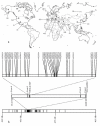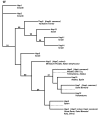The IGF1 small dog haplotype is derived from Middle Eastern grey wolves
- PMID: 20181231
- PMCID: PMC2837629
- DOI: 10.1186/1741-7007-8-16
The IGF1 small dog haplotype is derived from Middle Eastern grey wolves
Erratum in
- BMC Biol. 2010;8:118
Abstract
Background: A selective sweep containing the insulin-like growth factor 1 (IGF1) gene is associated with size variation in domestic dogs. Intron 2 of IGF1 contains a SINE element and single nucleotide polymorphism (SNP) found in all small dog breeds that is almost entirely absent from large breeds. In this study, we surveyed a large sample of grey wolf populations to better understand the ancestral pattern of variation at IGF1 with a particular focus on the distribution of the small dog haplotype and its relationship to the origin of the dog.
Results: We present DNA sequence data that confirms the absence of the derived small SNP allele in the intron 2 region of IGF1 in a large sample of grey wolves and further establishes the absence of a small dog associated SINE element in all wild canids and most large dog breeds. Grey wolf haplotypes from the Middle East have higher nucleotide diversity suggesting an origin there. Additionally, PCA and phylogenetic analyses suggests a closer kinship of the small domestic dog IGF1 haplotype with those from Middle Eastern grey wolves.
Conclusions: The absence of both the SINE element and SNP allele in grey wolves suggests that the mutation for small body size post-dates the domestication of dogs. However, because all small dogs possess these diagnostic mutations, the mutations likely arose early in the history of domestic dogs. Our results show that the small dog haplotype is closely related to those in Middle Eastern wolves and is consistent with an ancient origin of the small dog haplotype there. Thus, in concordance with past archeological studies, our molecular analysis is consistent with the early evolution of small size in dogs from the Middle East.See associated opinion by Driscoll and Macdonald: http://jbiol.com/content/9/2/10.
Figures





Comment in
-
The IGF1 small dog haplotype is derived from Middle Eastern grey wolves: a closer look at statistics, sampling, and the alleged Middle Eastern origin of small dogs.BMC Biol. 2010 Sep 8;8:119. doi: 10.1186/1741-7007-8-119. BMC Biol. 2010. PMID: 20825653 Free PMC article.
Similar articles
-
The IGF1 small dog haplotype is derived from Middle Eastern grey wolves: a closer look at statistics, sampling, and the alleged Middle Eastern origin of small dogs.BMC Biol. 2010 Sep 8;8:119. doi: 10.1186/1741-7007-8-119. BMC Biol. 2010. PMID: 20825653 Free PMC article.
-
Genome-wide SNP and haplotype analyses reveal a rich history underlying dog domestication.Nature. 2010 Apr 8;464(7290):898-902. doi: 10.1038/nature08837. Epub 2010 Mar 17. Nature. 2010. PMID: 20237475 Free PMC article.
-
Phylogenetic distinctiveness of Middle Eastern and Southeast Asian village dog Y chromosomes illuminates dog origins.PLoS One. 2011;6(12):e28496. doi: 10.1371/journal.pone.0028496. Epub 2011 Dec 14. PLoS One. 2011. PMID: 22194840 Free PMC article.
-
Evolutionary genomics of dog domestication.Mamm Genome. 2012 Feb;23(1-2):3-18. doi: 10.1007/s00335-011-9386-7. Epub 2012 Jan 22. Mamm Genome. 2012. PMID: 22270221 Review.
-
Deciphering the Origin of Dogs: From Fossils to Genomes.Annu Rev Anim Biosci. 2017 Feb 8;5:281-307. doi: 10.1146/annurev-animal-022114-110937. Epub 2016 Nov 28. Annu Rev Anim Biosci. 2017. PMID: 27912242 Review.
Cited by
-
Response to klütsch and crapon de caprona.BMC Biol. 2010 Sep 8;8:120. doi: 10.1186/1741-7007-8-120. BMC Biol. 2010. PMID: 20825654 Free PMC article.
-
A synonymous mutation in IGF-1 impacts the transcription and translation process of gene expression.Mol Ther Nucleic Acids. 2021 Aug 19;26:1446-1465. doi: 10.1016/j.omtn.2021.08.007. eCollection 2021 Dec 3. Mol Ther Nucleic Acids. 2021. PMID: 34938600 Free PMC article.
-
SINE Insertion in the Intron of Pig GHR May Decrease Its Expression by Acting as a Repressor.Animals (Basel). 2021 Jun 23;11(7):1871. doi: 10.3390/ani11071871. Animals (Basel). 2021. PMID: 34201672 Free PMC article.
-
Derived variants at six genes explain nearly half of size reduction in dog breeds.Genome Res. 2013 Dec;23(12):1985-95. doi: 10.1101/gr.157339.113. Epub 2013 Sep 11. Genome Res. 2013. PMID: 24026177 Free PMC article.
-
Long-read assembly of a Great Dane genome highlights the contribution of GC-rich sequence and mobile elements to canine genomes.Proc Natl Acad Sci U S A. 2021 Mar 16;118(11):e2016274118. doi: 10.1073/pnas.2016274118. Proc Natl Acad Sci U S A. 2021. PMID: 33836575 Free PMC article.
References
Publication types
MeSH terms
Substances
Grants and funding
LinkOut - more resources
Full Text Sources
Miscellaneous

